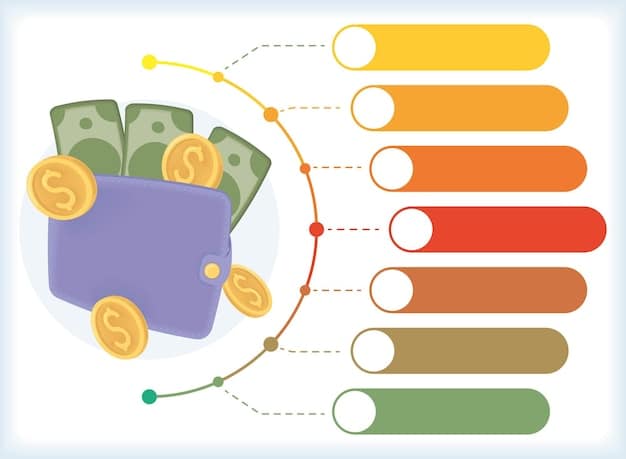Navigating 2025 Interchange Fee Changes: A Guide for E-commerce Businesses

How will the proposed 2025 changes to US payment card interchange fees impact your e-commerce business? These changes could significantly affect your operational costs and profitability. Understanding these potential shifts is crucial for strategic financial planning.
The landscape of payment processing is constantly evolving, and 2025 is set to bring significant changes to US payment card interchange fees. For e-commerce businesses, staying ahead of these changes is crucial to maintaining profitability and competitiveness. Understanding how will the proposed 2025 changes to US payment card interchange fees impact your e-commerce business? is not just about awareness; it’s about strategic planning.
This article aims to break down these proposed changes, explore their potential impact on your business, and offer actionable insights to help you navigate the evolving payment ecosystem. Let’s delve into the details of how your business might be affected and what you can do to prepare for these shifts in interchange fees.
Understanding Payment Card Interchange Fees
Payment card interchange fees are charges that merchants pay to the card-issuing bank for each transaction made with a credit or debit card. These fees are a significant component of the overall cost of accepting card payments, and they can vary widely depending on several factors.
Factors Influencing Interchange Fees
Interchange fees aren’t arbitrary; they are influenced by various elements. Understanding these factors can provide insights into why your business might be paying certain rates.
- Card Type: Credit cards, debit cards, and premium cards (like rewards cards) often have different interchange rates.
- Transaction Type: Card-present (in-store) and card-not-present (online) transactions typically have different rates, with online transactions generally incurring higher fees due to increased risk of fraud.
- Merchant Category Code (MCC): Different industries have different risk profiles, influencing the interchange fees they pay.
Changes in these factors, as well as broader market dynamics, can lead to adjustments in interchange fees. So, how will the proposed 2025 changes to US payment card interchange fees impact your e-commerce business? Understanding the landscape is vital.

In summary, being aware of these underlying components allows businesses to better anticipate and prepare for fluctuations in payment processing costs. Staying informed helps businesses make strategic decisions about payment methods and pricing strategies.
Overview of the Proposed 2025 Changes
The payment card industry is dynamic, and proposed changes to interchange fees in 2025 reflect this evolution. These changes aim to address various issues, and they could have a ripple effect on e-commerce businesses across the US.
Key Aspects of the Proposed Changes
Several key changes are being considered, each with distinct implications for e-commerce businesses. Therefore, understanding how will the proposed 2025 changes to US payment card interchange fees impact your e-commerce business? requires a look at these key aspects:
- Fee Adjustments for Specific Transaction Types: Some proposals suggest altering fees based on the size or nature of the transaction.
- Incentives for Enhanced Security Measures: There may be incentives for businesses that adopt advanced security protocols to reduce fraud.
- Changes to Card Network Rules: Card networks like Visa and Mastercard could introduce new rules impacting how interchange fees are assessed.
These proposed changes are not set in stone, and the final outcome may differ based on industry feedback and regulatory considerations. Keeping abreast of these ongoing discussions and developments will better prepare businesses by helping them strategize and budget appropriately.
In conclusion, staying attuned to the specifics of the proposed changes is essential for e-commerce businesses. This awareness enables informed decisions and proactive strategies to mitigate any potential negative impacts on profitability and operational efficiency.
How Will the Proposed 2025 Changes to US Payment Card Interchange Fees Impact Your E-commerce Business?
E-commerce businesses need to assess how will the proposed 2025 changes to US payment card interchange fees impact your e-commerce business? as they could experience a variety of effects—some positive, some negative—depending on their business model and payment strategies.
Potential Impacts on Profitability
One of the most significant concerns for e-commerce businesses is the potential impact on profitability. Understanding the financial implications is critical for making informed decisions.
- Increased Costs: Higher interchange fees on certain transaction types can directly increase the cost of doing business.
- Reduced Margins: If businesses cannot pass increased costs on to consumers, their profit margins could shrink.
- Competitive Disadvantage: Businesses that fail to adapt to the changes may find themselves at a competitive disadvantage compared to more agile competitors.
To mitigate these potential impacts, e-commerce businesses can reassess and adjust their pricing strategies, explore alternative payment methods, and negotiate with payment processors. Businesses must evaluate which options will protect their bottom line and maintain a competitive edge.

In conclusion, the 2025 interchange fee changes represent both a challenge and an opportunity for e-commerce businesses. Careful analysis and strategic adaptation are essential for maintaining profitability and thriving in the evolving payment landscape.
Strategies for Mitigating Potential Negative Impacts
Given the potential for negative impacts, it’s vital for e-commerce businesses to develop strategies to mitigate these risks. By proactively planning and implementing effective measures, businesses can minimize the adverse effects and even turn the changes into an opportunity.
Optimizing Payment Processing
Optimizing payment processing can significantly reduce the impact of increased interchange fees. Key strategies include the following:
Negotiate with Payment Processors
Negotiating rates with payment processors is a direct way to potentially lower costs. It is important for businesses to understand their volume, average transaction size, and risk profile.
Encourage Alternative Payment Methods
Offering and incentivizing the use of alternative payment methods, such as ACH transfers or digital wallets, which often have lower fees than traditional card payments, can help reduce overall costs. Businesses can provide discounts or loyalty points for customers who use these methods.
Implement Surcharging Where Allowed
Depending on regional regulations, surcharging—adding a small fee to card transactions to cover the interchange costs—can offset increased expenses. Transparency with customers about these fees is essential to maintain trust and avoid negative reactions.
- Detailed Transaction Data Analysis
- Optimized Payment Gateway
- Compliance and Security Investment
E-commerce businesses that take a proactive approach to optimizing their payment processing are better positioned to navigate the 2025 interchange fee changes and maintain profitability. Through negotiation, alternative payment methods, surcharging, data analysis, and security investments, businesses can mitigate negative impacts and improve overall financial performance.
Adapting to the Future of Payment Processing
The proposed changes to US payment card interchange fees in 2025 signal a shift in the payment processing landscape. For e-commerce businesses, adapting to this future requires not only mitigating immediate challenges but also embracing innovation and long-term strategic thinking.
Embracing Technological Advancements
Technology will play a key role in how e-commerce businesses adapt and thrive in the changing payment environment. The question therefore, becomes how will the proposed 2025 changes to US payment card interchange fees impact your e-commerce business? Adapting and embracing technology might be the answer.
- Artificial Intelligence (AI): AI can help identify fraudulent transactions and optimize payment routing, reducing costs and improving security.
- Blockchain Technologies: Blockchain-based payment systems offer enhanced security and transparency, potentially lowering transaction fees.
- Contactless Payments: As contactless payments become more prevalent, businesses should ensure their systems support these technologies to provide a seamless customer experience.
By adopting these technologies, e-commerce businesses can enhance the customer experience, reduce operational costs, and stay ahead of the curve in the evolving payment processing landscape. This proactive approach positions businesses for long-term success.
Finally, preparing to adapt to advances in technology helps ensure that e-commerce businesses will remain competitive and be able to handle the changes coming with the interchange fees proposed for 2025.
| Key Point | Brief Description |
|---|---|
| 💰 Understanding Fees | Interchange fees are charges for card transactions. |
| 📈 Impact on Profit | 2025 changes may affect e-commerce profitability. |
| 🛡️ Mitigation Strategies | Negotiate, offer alternatives, and surcharge when allowed. |
| 💡 Future Adaptation | Embrace AI, blockchain, and contactless payments. |
Frequently Asked Questions
Payment card interchange fees are fees charged by card-issuing banks to merchants for processing card payments. These fees compensate the card issuer for the risk and costs associated with providing credit and payment services.
Interchange fees are subject to change due to market conditions, regulatory pressures, and evolving security standards. These changes reflect ongoing efforts to balance the interests of banks, merchants, and consumers.
The changes could lead to increased processing costs, reduced profit margins, and the need to adjust pricing strategies. Staying informed and proactive is essential to mitigate these potential impacts.
Negotiate with payment processors, encourage alternative payment methods, implement surcharging where allowed, and optimize your payment gateway. These strategies can help reduce costs and improve profitability.
Emerging payment technologies, such as AI, blockchain, and contactless payments, can enhance security, reduce costs, and improve the customer experience. Embracing these technologies is crucial for long-term success.
Conclusion
The proposed 2025 changes to US payment card interchange fees represent a significant shift in the e-commerce landscape. Understanding how will the proposed 2025 changes to US payment card interchange fees impact your e-commerce business? and implementing proactive strategies are essential for maintaining profitability and competitiveness.
By staying informed, optimizing payment processing, and embracing technological advancements, e-commerce businesses can navigate these changes successfully and thrive in the evolving payment ecosystem. Careful planning and adaptation are, therefore, key to long-term success.





